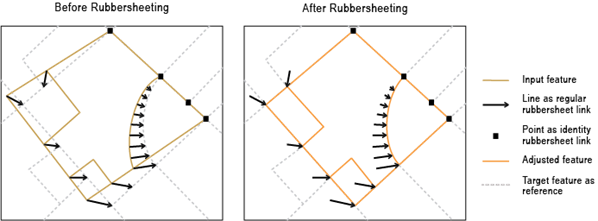Before aerial photography arrived most maps were highly inaccurate by modern standards.
Esri rubber sheeting.
Rubbersheeting is used to make small geometric adjustments in your data usually to align features with more accurate information.
For conceptual and detailed usage information refer to.
Rubbersheeting is used to make small geometric adjustments in your data usually to align features with more accurate information.
Rubber sheeting is a useful technique in historical gis where it is used to digitize and add old maps as feature layers in a modern gis.
Linear this method creates a quick tin surface but does not really take into account the neighborhood.
This exercise will show you how to rubber sheet data by using displacement links multiple displacement links and identity links.
This process moves the features of a layer using a piecewise transformation that preserves straight lines.
See about spatial adjustment rubbersheeting for more details.
It is slightly faster and produces good results when you have many rubbersheet links spread uniformly over the data.
Rubber sheeting may improve the value of such sources and make them easier to compare to modern maps.
The method parameter determines the interpolation method used to create the temporary tins in rubbersheeting.
About rubbersheeting rubbersheeting is typically used to align two or more layers.
Editing coverages tables with arcedit the adjust command in the arcedit command reference and understanding gis.
The source layer drawn with solid lines is adjusted to the more accurate target layer.
Rubbersheeting makes spatial adjustments to align the input feature locations with more accurate target feature locations based on the specified rubbersheet links.
In rubbersheeting adjustments you are usually trying to align one layer with another that is often in close proximity.
This tool is intended to be used following the generate rubbersheet links tool.

